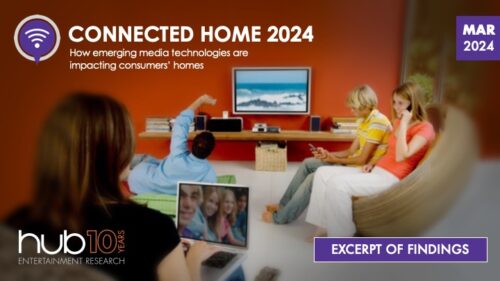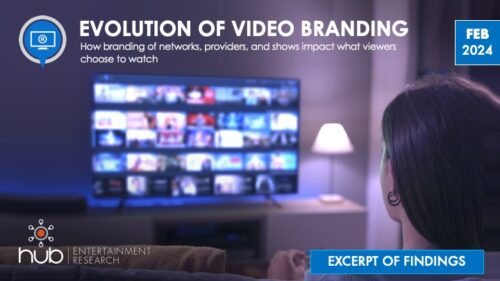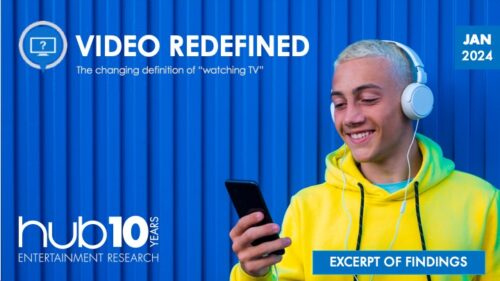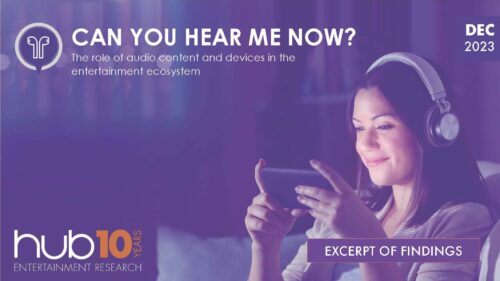Below you can download excerpts of our past reports. You can subscribe to receive the full report, respondent data and year-over-year trending. For more information on what we cover and how to sign up just fill out the contact form at the bottom of this page.
Click here to subscribe to our free newsletter: Hub Intel

How emerging media technologies are impacting consumers’ homes
LEARN MOREThe convergence of media and technology gets blurrier every year, as consumers dive deeper into technologies that give them 24/7 access to the digital content they know and love. Always-on internet access has networked together myriad devices – phones, smart TVs, smart speakers, kitchen gadgets, smart security systems, exercise equipment – that fill people’s days to make them more convenient, entertained and informed. Artificial intelligence is making these devices even more powerful and relied upon for everyday tasks, improving algorithms and data streams that help improve what consumers purchase and match them with the content they love.
Media delivery and data collection never takes a break, whether consumers are watching a TV at night, using a smartphone during their commute, listening to a smart speaker while making lunch, or recording their exercise on a smart watch before breakfast. Understanding what consumers own and use is more important than ever for the ever-increasing list of stakeholders in the media world.
2024 marks the fifth year of Hub’s Entertainment+Tech tracking study. As in previous years, the Connected Homereport will provide a broad look at entertainment and smart home technology in US households, as well as their intentions to purchase new media tech (e.g. Apple’s Pro Vision headset) and how they approach those purchases. With historical trends going back to 2019, our data reveals what devices are trending hot – or cold – in today’s media technology environment.
This study will continue to provide media producers & distributors and device manufacturers insights to help them make better informed strategy and investment decisions.
Source: Interviews with 5,026 U.S. consumers 16-74
Click here to subscribe to our free newsletter: Hub Intel
Get a Free Excerpt
How branding of networks, providers, and shows impact what viewers choose to watch
LEARN MOREOVERVIEW: Since 2019, Hub’s Evolution of Video Branding study has tracked awareness and perceptions of brands across the TV ecosystem.
As media companies enter 2024 and fill out their programming schedules, consumers are navigating an increasingly fragmented landscape of multiple streaming services and viewing sources. Production pipelines have been stalled by the Hollywood strikes, which will significantly impact when people see new shows. The recent trend of studios licensing content outside of their own streaming services to other streamers and FAST channels is providing even more choices and challenges for viewers seeking out favorite programs.
The most important goal of providers will continue to be around driving awareness, interest and differentiation in their services. With so many places to watch, providers must continue to focus on how their brands stand out from their rivals: exclusive content, library content, stacking series based on IP or creators, bundling with their other lines of business, or offering multiple subscription tiers.
In 2024, the Evolution of Video Branding study will continue to track not just awareness of streaming services, but also which service or brand attributes have had the strongest impact on consumers’ perceptions. Where available, trends with the previous four waves of the report will be shown.
Source: Interviews with 1,600 U.S. TV viewers with broadband access age 16-74
Get a Free Excerpt
The Evolution of Sports Media
LEARN MOREThe media industry is experiencing a new age of disruption.
Consumer behavior is becoming much more unpredictable due to the introduction of streamers, user-generated content, and many other media to consume content.
However, it is a common belief that there is one genre of content that continues to drive passion and demand: sports.
What’s the Score? Is Hub’s inaugural exploration of how fans and consumers value sports – including sports-adjacent content. Live games are typically the main appeal, but what are the interest levels across alternative broadcasts (such as ESPN’s “Manningcast”), sports betting, podcasts, etc.?
More specifically, What’s the Score? aims to understand sports fandom vis-a-vis consumption platforms. How ‘sticky’ is exclusive content on a platform for subscribers’ or viewers’ retention or acquisition? Does it differ by major US sports? Does fragmentation impact the overall fan experience?
As rights continue to shift across broadcast, pay TV, streaming, and direct-to-consumer, it is becoming increasingly important to understand the value of sports content for all stakeholders.
Hub’s research will provide anyone who creates, distributes, and advertises on sports content with a deeper, more nuanced understanding of how much sports matter to your audience, and why.
Source: Interviews with 3,016 U.S. Sports Fans with broadband access age 13-74
Get a Free Excerpt
The changing definition of “watching TV”
LEARN MOREOur annual Video Redefined study steps back from our usual focus on the delivery and viewership of traditional TV and streaming services on TV sets in order to explore new ways of viewing – tracking use of the newer types of video content and ways of video consumption now at consumers’ disposal.
This study tracks the growing popularity of content categories like YouTube influencers, TikTok, and podcasts. We look at how consumption of non-TV-screen content varies by consumer segment, the most common use-cases, and consumers’ reaction to advertising on non-TV-screen video platforms. And of course, one of the main goals of the study is to measure the impact that consumption of this content is having on traditional TV viewing.
This study helps our TV industry and advertising clients better understand the competitive challenges posed by “off-TV-screen” content and how those challenges are evolving, the opportunities being created by these alternative viewing options, and what strategies may be effective for their businesses.
Source: Interviews with 1,900 U.S. TV viewers with broadband access age 13-74
Get a Free Excerpt
The role of audio content and devices in the entertainment ecosystem
LEARN MOREIn 2022, according to the Radio Advertising Bureau and Nielsen, 82% of Americans ages 12 and older listened to terrestrial radio in a given week. And according to Edison Research’s “The Infinite Dial” report, in 2023 42% of Americans 12+ have listened to a podcast in the past month. “Audio” – whether terrestrial or satellite radio, or streaming music, or podcasts – remains a substantial portion of the media mix for Americans, yet it often is overshadowed by research on TV and streaming video. And with the proliferation of Bluetooth-enabled TV sets and TV devices, or viewing on mobile devices with that capability, listening to TV audio is increasingly through headphones and earbuds, impacting TV viewing habits long taken for granted by the industry.
In this new report, Hub explores how people interact with audio (the devices they use to listen), their listening content (what services they are using for audio), and how people listen to TV with alternative audio devices. We also will explore how audio content like podcasts can be used to increase sampling and engagement with programs on traditional TV and streaming services, or as source material for video programming.
And as always, this report from the Entertainment & Technology Tracker will include quarterly tracking questions on a multitude of home media technologies.
Source: Interviews with 2,501 U.S. consumers 16-74
Get a Free Excerpt
What is the future of ad-supported TV in a streaming world?
LEARN MOREAs more and more streaming services adopt an ad-supported model, the importance of understanding advertising’s role in the TV ecosystem – and in viewer’s subscription and viewing decisions – has never been more important. While Netflix, Disney+, and Max work to draw subs to their new ad tiers, Amazon and AMC+ recently announced their push to ad commercials to their streams. Soon there may be few truly ad-free streamers left – if any.
Our TV Advertising: Facts vs. Fiction study has consistently shown viewers are open to and tolerant of advertising – especially when ad loads are reasonable, when users’ bills are lower, and when they have the option to choose a premium ad-free options if they so desire. Time and again we see consumers choosing content first – whether or not they can watch it ad-free.
In this sixth wave of TV Advertising – Fact vs. Fiction, we will continue to track use, viewing behaviors, and perceptions of ad-supported TV. We’ll explore the interplay between advertising, cost, and content, and how they inform platform choice:
In the end, the goal of the study is to help TV service and content providers offer an ad experience that will maximize viewer satisfaction, engagement, and loyalty.
Source: Interviews with 3,000 US TV Viewers age 14-74
Get a Free Excerpt